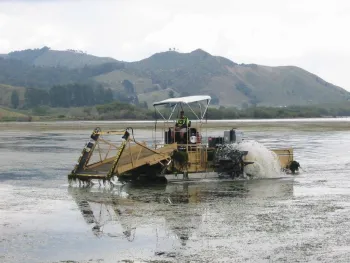Mechanical control techniques may physically damage shoots, roots, or root crowns of plants to the point where they can no longer survive. Alternatively, mechanical control options can remove the entire plant. These methods include hand-pulling, diver-operated suction harvesting, rototilling, harvesting, cutting, shredding, or weed rakes. These techniques can be expensive and slow, but they do remove weeds thoroughly and promptly.
Manual removal
Hand-pulling is a valuable tool for preventing initial infestation or controlling small populations of potentially important weed species. It is also effective for the control of small infestations at the fringe of the major infestation, or when finding individual plants during survey or monitoring. All vegetative reproductive fragments must be removed from the water or sediment to prevent resprouting.
Under some circumstances, manual methods of control can be successful with woody species. However, they are very labor intensive and require continual follow-up control efforts.
Harvesting or cutting

For aquatic weed management, the difference is that cutting does not remove plant material, while harvesting loads the cut material onto a barge for transport out of the system.
If timed correctly with biennial and perennial plants, cutting can prevent flowering and seed set, and reduce carbohydrate reserves. Repeated harvesting or cutting on perennial weeds can prevent seed production, greatly reduce plant vigor, deplete carbohydrate reserves, and can give advantages to desirable perennial grasses. On the negative side, it can result in dissemination of stem fragments or seeds and can stimulate production of new stems from vegetative buds below the cut surface.
With harvesting, the removal and processing of plant material becomes a major issue. Aquatic plant material is typically 90% or more water weight, thus plant material is very heavy for the volume. Plants require a considerable time to dry or compost, and have little value as food or forage. Drying plant material is odoriferous, and does not make for a good green mulch around residential areas.

The disadvantages to the use of heavy equipment include its high cost and significant disturbance to the surrounding area. In addition, heavy equipment is of limited use on complex or sensitive terrain, or on severe slopes, and may interfere with reestablishment of native plants and animals. In irrigation ditches or ponds where heavy equipment is available, dredging can be used effectively to remove emerged aquatic species, although this too often leads to resprouting from fragments left behind.
Water management

In water systems, it may be possible to manipulate water level at a particular time of the year to achieve control of aquatic species. This is most practical in irrigation canals or some lakes, reservoirs and ponds where water levels can be controlled during the year. A drawdown (dewater) involves lowering the water in an aquatic system to expose sediments in the areas near the shore. The degree of plant control from a drawdown is dependent on plant species and temperature. A drawdown accompanied by freezing temperatures provides the greatest aquatic plant control. Raising the water level can also provide some level of control for a few emergence aquatic species. For example, flooding of purple loosestrife or perennial pepperweed is effective if plants can be inundated throughout the growing season. The drawback to drawdown, however, is that it is also detrimental to most other emergent species and can promote the spread of the weeds to shallow areas.
Benthic Barrier
Benthic barriers can be economical to control small weedy paths in aquatic areas. Although they are usually made of impermeable plastics, other materials such as jute can be used. The barriers primarily control aquatic weeds by blocking light penetration to the sediment surface. While plastic barriers need to be removed after a period of time, jute and other biodegradable natural barrier materials can be left in place to decompose. Benthic barriers do not require registration with federal EPA or state agencies and have minimal impact on the water column and non-target organisms. The disadvantages to benthic barriers are that sediment accumulation may occur on top of the barriers where weeds may then germinate and grow. In addition, the barriers may be lifted up by gas bubbles that are produced from the sediment. Although jute is a biodegradable product, it often does not provide adequate control of weed propagules.
